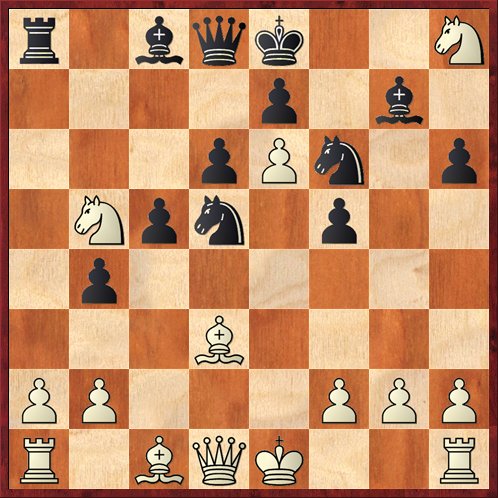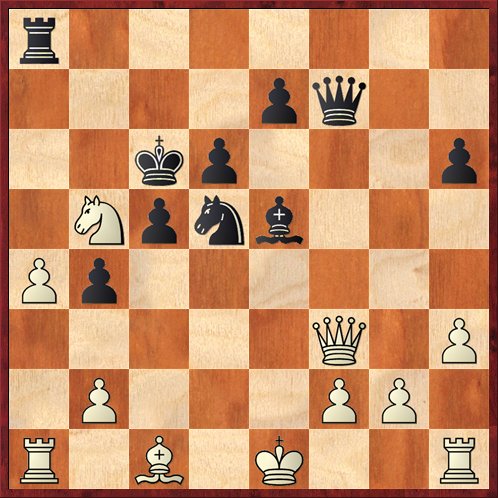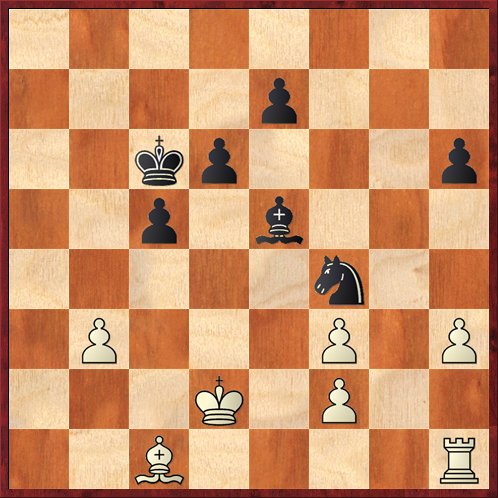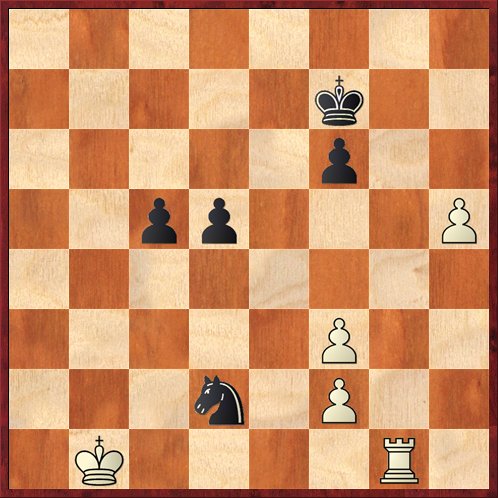At yesterday’s chess party at Mike Splane’s house, Bryon Doyle showed one of his two miraculous wins from the recent Sacramento Championship, where he tied for first place with his girlfriend Uyanga Byambaa. (Uyanga was also at the party and showed one of her games.) Bryon said over and over that he was just lucky in this game, and in the tournament. How lucky? Well, let’s see.
The game below was his fifth-round game against a master named Robert Hatarik, who was playing White. Let’s start at Black’s 17th move.
 FEN: r1bqk2N/4p1b1/3pPn1p/1Npn1p2/1p6/3B4/PP3PPP/R1BQK2R b KQq – 0 17
FEN: r1bqk2N/4p1b1/3pPn1p/1Npn1p2/1p6/3B4/PP3PPP/R1BQK2R b KQq – 0 17
Position after 17. Nxh8. Black to move.
Bryon, playing Black, has botched the opening about as badly as one can; he was caught in a tricky variation of the Benko Gambit that he didn’t know. He’s just lost his rook, and I’m sure his opponent expected him to recapture on h8. But he didn’t!
17. … Bxe6 ?/!
This is a move for which the customary symbol ?! is kind of inadequate. On the one hand, it’s objectively a blunder. 17. … Bxh8 is a better move. The principal reason it’s better is that not only does Black recover part of his material, but White faces many of the same problems as in the game. That is, after 17. … Bxh8 18. Bxf5 Qa5! it’s hard to see how White is going to rescue the knight on b5. (I’m not saying he can’t; my recommendation would be 19. Qd2! Qxb5 20. Bd3! followed by Qxh6, which recovers the piece due to the mate threat on the back rank.)
Be that as it may, the amazing move 17. … Bxe6 set the tone for the rest of the game. Black is willing to play down a whole rook for a pawn, but he has huge compensation. His pieces are active and centralized, his king is safe, and most importantly White still has the problem of how to save his knight on b5.
Not only that, I think that psychologically most players are ill-equipped to deal with a position with such a radical material imbalance. It’s clear that Black has a lot of compensation for the rook. How much? Two pawns? Three pawns? It’s hard to tell! Most players have an intuitive sense for “sufficient compensation for a pawn” or for an exchange, but we don’t have an intuitive sense for “sufficient compensation for a rook.” This fact leaves both players groping in the dark a little bit. When your opponent is trying to win the game, that’s an awkward place for him to be in.
So I vigorously applaud Bryon’s chutzpah, even if his move was probably not the best.
Here is how the game continued:
18. Ng6 Ng4 19. h3?! …
Already White is playing too routinely. Black’s pieces are active but they are also rather widely scattered, and the move 19. Nf4! would take advantage of this. It looks as if Black wins material with 19. … Nxf4 20. Bxf4 Bxb2, but White has the nasty followup 21. Qe2! Bxa1 22. Qxe6. Material is (temporarily) back to even, but White has two threats that can’t both be defended: 23. Nxd6+ or 23. Bxf5, both with mating threats to follow.
But again, psychology is an important factor. Players who are a rook up seldom want an all-out slugfest. They just want to deaden the position, trade material, play simple moves that don’t require calculation. When you are losing, you can sometimes exploit this tendency, either by forcing non-routine moves your opponent isn’t comfortable with, or by anticipating the routine moves and looking for flaws in them.
19. … Ne5 20. Nxe5 Bxe5 21. Qh5+ Kd7 22. Bxf5 Bxf5 23. Qxf5 Kc6 24. a4 Qg8 25. Qg4 Qf7 26. Qf3? …
 FEN: r7/4pq2/2kp3p/1Npnb3/Pp6/5Q1P/1P3PP1/R1B1K2R b KQ – 0 26
FEN: r7/4pq2/2kp3p/1Npnb3/Pp6/5Q1P/1P3PP1/R1B1K2R b KQ – 0 26
Position after 26. Qf3. Black to move.
Observe how White has been trading all of his active pieces, leaving him only pieces that are undeveloped or (in the case of the knight on b5) have no moves. This is not a good way to play chess, even when you are a rook ahead.
Bryon’s next move shows very good judgement. Even though you wouldn’t ordinarily expect someone to trade queens when down in material, he recognizes that (a) White’s pawn structure on the kingside will be crippled; (b) Black now has a tactical resource that wins the knight on b5. White has only himself to blame; he has traded off all the pieces that could defend it.
26. … Qxf3! 27. gf Nb6!
The a-pawn falls, and then what is the knight to do?
28. Ra2 Rxa4 29. Rxa4 Nxa4 30. Na7+ Kb7 31. Nb5 Kc6
Offering a draw by repetition, which of course White doesn’t want. But he must be pretty upset by now. Earlier he had a position that he thought he could win just by playing routine moves and trading pieces. Now he’s got a position he will have to work to win. Can White recover psychologically?
32. b3 Nb6 33. Na3 ba 34. Bxa3 Nd5 35. Bc1 Nf4 36. Kd2! …
FEN: 8/4p3/2kp3p/2p1b3/5n2/1P3P1P/3K1P2/2B4R b – – 0 36
Position after 36. Kd2. Black to move.
I have to give Hatarik some credit here. He’s gotten his head back into the game enough to come up with a non-obvious plan with 36. Kd2. His idea is to play 37. Kc2 and 38. Bb2, trading off the bishops. It’s much, much easier for White to win the R-versus-N endgame than to win the R-versus-B endgame, where it appears Black would have a very good chance to put all his pawns on dark squares and set up a blockade.
It’s now time for Bryon to make a careless mistake. He didn’t ask himself what his opponent is doing, but instead made a routine move, centralizing his king. During the chess party we discussed the move 36. … d5, but I don’t think that is best either.
I think that this is the time for a Unique Opportunity Move: 36. … c4! Black takes advantage of the fact that White’s pieces are all stepping on each other’s toes, and that he can’t defend the pawn after either 37. bc Kc5 or 37. b4 Kb5. Either way Black’s king becomes a very active piece. Also, trading the b- and c-pawns is a big step toward drawing, because it shortens the board (better for the side with less material) and it means that White will have to use his lame f- and h-pawns if he wants to win the game.
Instead, Black played 36. … Kd5?! I think that Bryon was too hard on himself in criticizing this move, though. It’s well-motivated; the king can either help the queenside pawns advance or he can help defend the kingside.
The game continued 37. Kc2 Ne2 38. Bxh6.
With this move, White has taken a big step toward winning. Previously he was struggling to find a plan, but now it is as simple as can be: try to push his pawn to h8.
As a consolation prize, Black wins the b3 pawn. Two connected passed pawns are pretty good consolation.
38. … Nd4+ 39. Kb1 Nxb3 40. h4 Ke6 41. Bg5 Kf7 42. h5 d5?
A little bit impatient. Now White gets exactly what he wanted earlier: a trade of bishops.
43. Re1 Bf6 44. Bxf6 ef 45. Rg1! …
Now it once again looks as if White is easily winning, as Black’s king is cut off from the passed pawn. Perhaps Hatarik relaxed and let down his guard here. In reality, he still has to be careful.
45. … Nd2+
FEN: 8/5k2/5p2/2pp3P/8/5P2/3n1P2/1K4R1 w – – 0 46
Position after 45. … Nd2+. White to move.
Be careful! What is White’s best move here?
Clearly Black is going to take on f3 next. All that White needs is to put his king on a square where it cannot be checked from f3, because that check will give Black the tempo he needs to defend the h-pawn. Therefore, 46. Kc1! is the right move. Of course Black can check on b3 instead, but 46. … Nb3+ 47. Kd1 Nd4 48. h6 and the knight gets to f5 too late.
Even after 46. Kc1! White has to play accurately. After 46. … Nxf3 47. Rg4! Ne5 48. Rg3 f5 49. h6 Ng4 50. h7 Kg7 51. f3.
Instead White played 46. Kc2? Nxf3 47. Rg2?? One blunder leads to an even worse one! But even on the correct 47. Rg3 Nd4+ 48. Kd3 Nf5 I think it will be very hard, maybe even impossible for White to win.
Alas, White probably focused only on the d4 square and forgot that there is another check…
47. … Ne1+! White resigns
A stunning reversal! Never forget the forking power of the knight in the endgame. As I have written before on this blog, “Knights in time trouble are worth double.” I can’t prove it, but here it certainly turned out to be true.
Okay, maybe Bryon got a little bit lucky at the end, but more than anything else this game was about the value of perseverance. Probably his perseverance “should” have been rewarded with a draw, but sometimes the gods of chess are even more generous than we deserve!





{ 2 comments… read them below or add one }
“A win by an unsound combination, however showy, fills me with artistic horror.” – Wilhelm Steinitz
Glad you enjoyed the game! I wasn’t sure about my move bxe6 but it seemed like my best chance to complicate the position (at least I have a small initive there. Lots of mistakes I made though, nh5? , f5??, kd5?, and d5?? (I rushed too much) but it was a good fight, and a lot of luck helped too 🙂
This has been a good game for me to go over, I have learned a lot 🙂
{ 1 trackback }